The most effective LED treatments for heart health combine red light therapy (630-670nm) and near-infrared light (830-850nm) for ideal circulation benefits. You'll want to focus on your chest area for 10-15 minutes, 2-3 times weekly, keeping the device 6-12 inches from your body. Try pulsed light delivery systems for deeper penetration, and combine treatments with gentle movement for enhanced blood flow. Target your upper body in the morning, lower body in the evening, and consider full-body sessions for systemic benefits. Don't forget to stay hydrated and practice stress management during treatments. The science behind these protocols reveals even more powerful ways to boost your cardiovascular health.
Understanding LED Light For Circulation
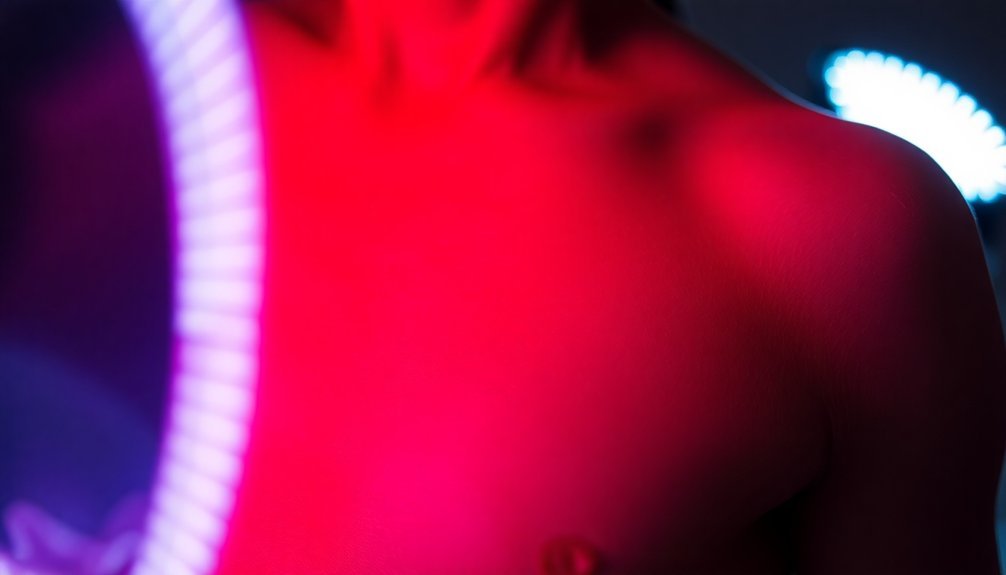
Your heart's constant rhythm powers a complex network of blood vessels that keep you alive and healthy. When you use LED light therapy, particularly red wavelengths, you're tapping into a natural way to enhance this essential circulation system. The therapy works by stimulating your body's production of nitric oxide, a compound that relaxes your blood vessel walls and promotes better blood flow.
As red light penetrates your tissue, it triggers a series of beneficial reactions. This safe and non-invasive approach typically requires 20-minute treatment sessions. You'll experience improved microcirculation as the light reaches tiny blood vessels and capillaries, helping deliver oxygen and nutrients more efficiently to your cells.
This enhanced blood flow doesn't just support your cardiovascular system – it's actively working to reduce inflammation and support your body's natural healing processes.
What makes LED light therapy particularly effective is its ability to boost circulation at multiple levels. You'll benefit from better oxygenation throughout your body, which is important for muscle recovery and tissue repair.
The therapy also supports your lymphatic system, helping remove metabolic waste and reduce swelling. These combined effects make LED light therapy a powerful tool for maintaining healthy circulation and supporting your overall cardiovascular wellness.
Red Light Wavelength Benefits
Red light wavelengths between 630-900nm work at the cellular level to repair and rejuvenate your heart's tissues through enhanced mitochondrial function.
You'll experience improved circulation as the light stimulates nitric oxide production, which naturally dilates your blood vessels and promotes better blood flow throughout your body.
These therapeutic wavelengths penetrate deep into your tissues, supporting both immediate circulation benefits and long-term cardiovascular health through reduced inflammation and improved cellular energy production. The therapy has shown promising results in treating heart failure by reducing heart size and improving cardiac function.
Cellular Repair Through Light
Through advanced photobiomodulation technology, light-based treatments have revolutionized cellular repair at the deepest levels. When red light penetrates your tissue, it triggers a cascade of healing responses within your cells, particularly in the mitochondria – your cellular powerhouses. This stimulation leads to increased ATP production, enhanced oxygen utilization, and improved cellular metabolism.
Your body's natural repair mechanisms become supercharged as red light therapy influences key cellular pathways. It's not just about surface-level healing; the light actually modifies your cellular behavior, reducing inflammation and oxidative stress while promoting tissue regeneration. Research shows that intense light exposure can boost PER2 gene expression, which helps protect heart tissue during low oxygen conditions.
- Your mitochondria become more efficient at producing energy, leading to better overall cellular function and repair
- Your cells experience reduced oxidative stress, which helps prevent damage and supports longevity
- Your inflammatory response becomes better regulated through the modulation of cytokines and signaling molecules
- Your stem cells in bone marrow become activated, contributing to improved blood flow and tissue healing
The cellular repair process extends beyond basic healing, as red light therapy influences intracellular biochemical cascades and supports your body's natural regenerative abilities, particularly beneficial for maintaining heart health and reducing cardiovascular risks.
Bloodflow Promotion Benefits
Light-based treatments extend beyond cellular repair to directly boost circulatory health through specific wavelengths. When you expose your body to red light therapy between 630-700 nanometers, you'll trigger increased nitric oxide production, causing your blood vessels to relax and dilate. Your body maintains essential pH and temperature through this improved blood flow.
| Benefit | Impact |
|---|---|
| Nitric Oxide | Relaxes blood vessels for better flow |
| Oxygen Delivery | Increases nutrient-rich blood to tissues |
| Inflammation | Reduces swelling and promotes healing |
| Heart Function | Improves mitochondrial efficiency |
You'll experience enhanced circulation as oxygen-rich blood flows more freely through your dilated vessels, delivering essential nutrients to your tissues. This improved blood flow can substantially help if you're dealing with Peripheral Artery Disease, increasing your pain-free walking distance.
The therapy's impact on heart health is particularly important. If you have heart concerns, you'll benefit from reduced inflammation and oxidative stress in cardiac tissue. Studies show that regular sessions can improve heart function in those with heart failure, while also protecting against potential damage during surgeries. The standard 15-minute treatment sessions make it convenient to incorporate into your daily routine while sitting or lying down.
Deep Tissue Penetration Methods
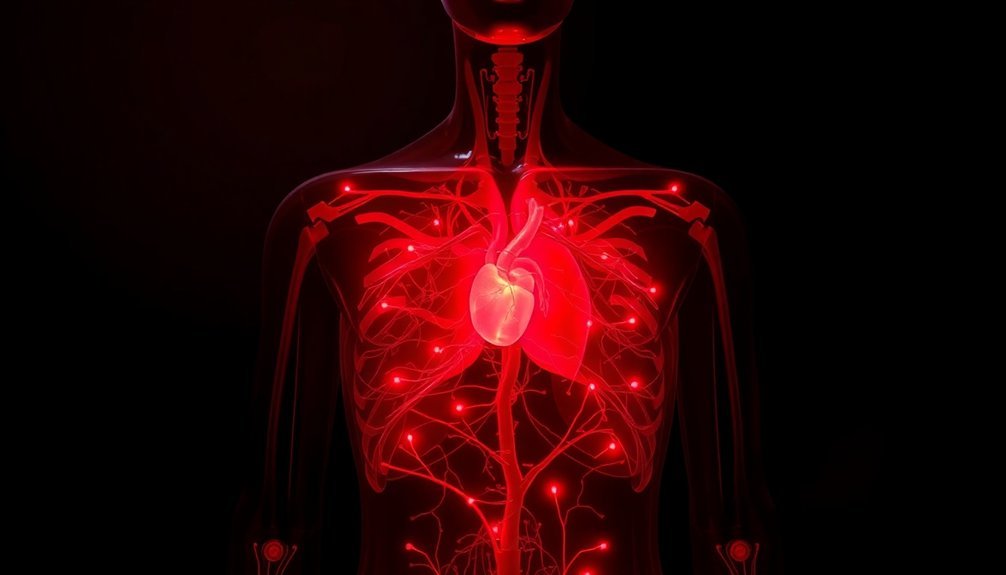
Numerous LED treatment methods have evolved to maximize deep tissue penetration for heart health applications. You'll find that near-infrared wavelengths, particularly 830nm, penetrate deeper into your cardiovascular tissues than traditional red light therapy.
When you're seeking heart health benefits, it's essential to select devices that operate within the therapeutic window of 600-1200 nanometers, as these wavelengths effectively reach deeper tissues without being absorbed by water or melanin in your skin.
For the best cardiovascular benefits, you'll want to think about these essential treatment approaches:
- Combine large LED arrays with focused contact devices to achieve both systemic and localized effects on your cardiovascular system
- Use pulsed light delivery systems, which drive energy more effectively into deep tissue than continuous wave applications
- Select near-infrared wavelengths (830nm-1072nm) for maximum penetration depth up to 10mm
- Allow adequate exposure time to activate systemic healing mechanisms throughout your cardiovascular system
Your treatment's effectiveness depends heavily on proper device selection and application method. By using LED arrays that cover larger body areas, you'll trigger systemic effects that benefit your entire cardiovascular system, while targeted applications can address specific circulatory concerns.
Blood Flow Enhancement Techniques
While LED therapy offers deep tissue benefits, maximizing its effects requires a thorough approach to blood flow enhancement. You'll want to combine light therapy with proven circulation-boosting activities to achieve the best results. Regular aerobic exercises like swimming or cycling can substantially improve your cardiovascular health while preparing your body for LED treatments.
| Activity | Benefit |
|---|---|
| Interval Training | Enhances blood vessel flexibility and circulation |
| Stress Management | Prevents vessel constriction and promotes vasodilation |
| Hydration | Maintains ideal blood viscosity and flow |
| Strength Training | Increases blood flow to specific muscle groups |
When you're implementing LED therapy, you'll get better results by incorporating relaxation techniques like meditation or deep breathing exercises. These practices help dilate your blood vessels, allowing the light therapy to penetrate more effectively. You should also consider maintaining proper hydration and managing your stress levels, as these factors directly impact your circulation. If you're looking to enhance your results further, supplements like ginkgo biloba can support better blood flow, though you'll want to consult your healthcare provider before starting any supplement regimen.
LED Treatment Duration Guidelines

To achieve the best results with LED therapy, you'll need to follow specific timing guidelines based on your treatment goals.
For circulatory benefits and heart health, you'll want to position the device 15-30 cm from your target area and maintain consistent sessions of 10-15 minutes, 2-3 times per week. This timing allows for maximum light penetration and therapeutic dose delivery of approximately 18 joules/cm2.
You'll see the best results over a 4-6 week period of regular treatments, followed by maintenance sessions.
When using handheld devices, spend at least 5 minutes per treatment zone to guarantee adequate exposure. Remember to clean your skin beforehand and apply hydrating products afterward to maximize benefits.
- Use shorter 30-second to 3-minute sessions when treating areas closer to the heart to avoid overexposure.
- Start with lower durations if you're new to LED therapy, then gradually increase as your body adapts.
- Maintain consistent treatment times and frequencies for maximum blood flow enhancement.
- Monitor your body's response and adjust session duration accordingly, never exceeding 30 minutes per area.
Optimal Device Placement
Proper device placement builds on careful timing to maximize LED therapy's circulatory benefits. You'll need to position your device within the ideal photobiomodulation zone of 10-50 mW/cm², which typically means placing panels 6-48 inches away from your body, depending on their intensity.
| Device Type | Best Distance | Key Position | Safety Note |
|---|---|---|---|
| Heart Panels | 12-24 inches | Chest-centered | Avoid direct contact |
| Full Body | 16-36 inches | Standing/lying | Even distribution |
| Targeted Wraps | 0-2 inches | Direct application | Monitor heat |
| Face/Neck Masks | Built-in spacing | Facial alignment | Eye protection |
For cardiovascular benefits, you'll want to focus the light on your chest area while maintaining proper distance to prevent tissue heating. Don't position devices too close, as this can create EMF exposure and excessive heat. Similarly, placing them too far reduces therapeutic effectiveness. When using multiple panels, guarantee uniform coverage without creating hotspots. Always follow your manufacturer's specific guidelines, as intensity levels vary between devices. If you're using a professional setup, work with your practitioner to find the best positioning for your treatment goals.
Combining LED With Movement

While research hasn't directly linked LED therapy with movement for heart benefits, you'll want to stay active during your LED treatment sessions when possible.
You can perform gentle exercises like walking in place, arm circles, or light stretching while the LED light shines on your target areas.
Combining LED therapy with cardiovascular movement may enhance blood flow, though more studies are needed to confirm this potential synergistic effect.
Move While Light Shines
Combining LED light therapy with movement creates a powerful synergy for cardiovascular health. As you exercise during light therapy sessions, your blood vessels dilate, allowing for enhanced oxygen and nutrient delivery throughout your body.
This dual approach not only improves circulation but also accelerates tissue repair and muscle recovery.
You'll notice significant benefits when you incorporate gentle movements during your LED therapy sessions. The combination helps reduce inflammation at the cellular level while promoting better muscle function and nerve regeneration.
It's particularly effective for athletic performance and recovery, as it protects against muscle damage while strengthening neuromuscular coordination.
- Your blood circulation improves dramatically when you combine light therapy with physical activity, ensuring oxygen-rich blood reaches damaged tissues
- You'll experience faster muscle recovery and reduced inflammation, especially beneficial after intense workouts
- The combination helps strengthen your muscles while protecting them from exercise-related damage
- You'll notice enhanced nerve regeneration and improved coordination, supporting long-term health benefits
For the best results, maintain consistent movement during your LED therapy sessions, focusing on gentle exercises that target your specific recovery goals.
Cardio Enhances LED Benefits
Physical activity's relationship with LED therapy creates a remarkable boost to your heart's overall function. When you combine cardio exercises with LED treatments, you'll experience enhanced blood vessel dilation, leading to improved nutrient and oxygen delivery throughout your body. This dual approach activates cardiac adenosine, which helps regulate your blood flow more effectively.
| Benefit | LED Effect | Combined with Movement |
|---|---|---|
| Blood Flow | Dilates vessels | Multiplies circulation benefits |
| Heart Protection | Activates TGF-β1 | Strengthens cardiac muscles |
| Nerve Health | Promotes repair | Enhances neuromuscular coordination |
You'll notice significant improvements in your cardiovascular health as the therapies work together to protect your heart tissue during oxygen-related challenges. The combination targets multiple aspects of heart health: while LED therapy increases cardiac adenosine and activates growth factors, your physical movements complement these effects by strengthening your heart muscle and improving overall circulation. This synergistic approach doesn't just enhance your immediate heart function – it contributes to long-term cardiovascular health and may even offer protection during high-risk procedures. You'll experience reduced inflammation, better muscle conditioning, and improved mobility through this integrated therapeutic approach.
Safety Protocols For Heart Health
Following essential safety protocols plays a vital role in maintaining heart health and preventing cardiovascular issues. You'll need to focus on four key areas: diet, physical activity, lifestyle management, and regular monitoring.
Start by adopting a heart-healthy diet rich in fiber, low in saturated fats, and limited in sodium and added sugars. Incorporate at least 150 minutes of moderate exercise weekly, breaking it down into manageable 30-minute sessions.
Managing your lifestyle factors is equally important. You'll want to practice stress-reduction techniques, maintain healthy sleep patterns, and avoid harmful habits like smoking.
Regular monitoring of crucial health markers, including blood pressure, cholesterol, and blood sugar levels, helps you stay on track with your heart health goals.
- Adopt Mediterranean or DASH diet principles, focusing on whole foods, lean proteins, and healthy fats
- Engage in activities that raise your heart rate to 50-70% of maximum capacity, such as brisk walking or cycling
- Practice stress management through deep breathing, meditation, or yoga daily
- Schedule regular check-ups to monitor key health indicators and adjust your treatment plan accordingly
Monitoring Progress During Treatment
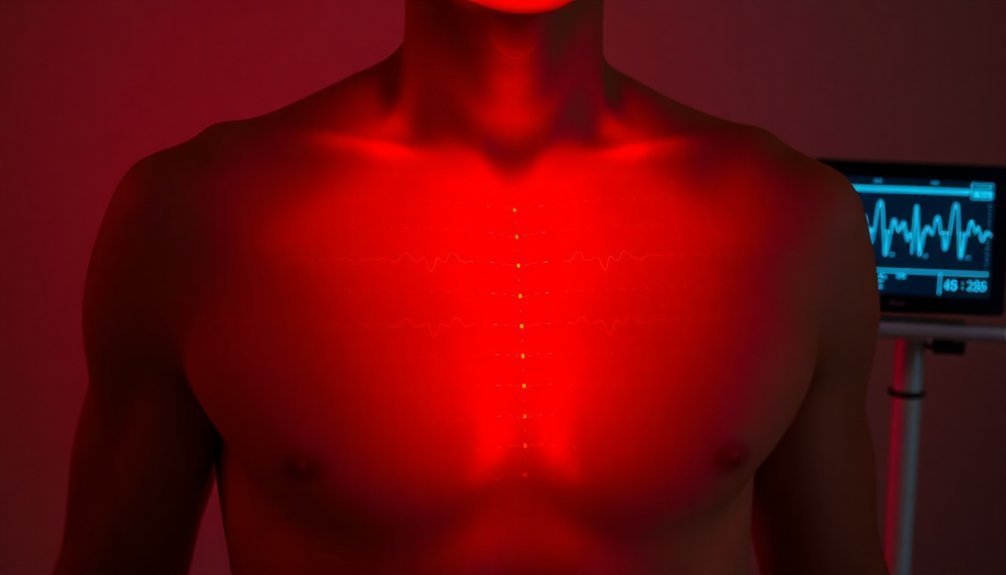
A thorough monitoring strategy is essential when undergoing LED treatment for heart health. During your treatment, medical professionals will use echocardiography to track improvements in your heart's function. This imaging technique measures vital indicators like ejection fraction and fractional shortening, which show how well your heart contracts.
You'll undergo regular histological and morphological analyses to assess changes in your cardiac tissue structure. These tests reveal whether there's a reduction in pathological cardiac hypertrophy and tissue disorders.
Your healthcare team will track ratios like HW/BW and HW/TL to monitor improvements in heart size.
Another critical measurement you'll encounter is the lung wet weight to dry weight ratio, which indicates pulmonary edema levels. As your treatment progresses, a decrease in this ratio suggests less fluid accumulation in your lungs and improved heart function.
You'll benefit from real-time monitoring through advanced systems like CardioMEMS, which continuously track fluid buildup in your lungs. This technology allows your healthcare providers to make timely adjustments to your treatment plan and intervene early if complications arise, helping prevent potential hospitalizations.
Frequently Asked Questions
Can LED Treatments Interfere With Cardiac Pacemakers or Other Heart Devices?
While LED light therapy is generally safe, you'll want to maintain distance between the device and your cardiac implant. Modern pacemakers have protection against interference, but it's best to consult your doctor first.
How Soon After Heart Surgery Can I Safely Begin LED Therapy?
You'll need your doctor's specific approval before starting LED therapy after heart surgery. While it can aid healing, timing varies based on your procedure, recovery progress, and overall health condition.
Should I Adjust LED Treatment Intensity Based on My Blood Pressure?
Yes, you'll need to adjust LED intensity based on your blood pressure levels. Work with your healthcare provider to monitor changes and modify treatment intensity, especially if you're experiencing significant blood pressure fluctuations.
Can LED Therapy Replace Prescribed Heart Medications or Supplements?
You shouldn't replace prescribed heart medications with LED therapy. While it shows promise, it's not proven as a replacement. Always consult your doctor before making changes to your prescribed medication or supplement routine.
Are There Specific Clothing Materials That Block LED Effectiveness for Heart Health?
Yes, you'll want to avoid thick fabrics like wool, denim, and layered clothing during LED treatments. Dark-colored and synthetic materials can also block light penetration, so wear thin, light-colored, single-layer garments instead.
In Summary
You've now learned key strategies for using LED light therapy to support your heart health and circulation. By following proper wavelength selection, treatment timing, and safety guidelines, you'll maximize the benefits for your cardiovascular system. Remember to monitor your progress and combine these treatments with regular movement. Start slowly with these LED protocols and consult your healthcare provider before beginning any new treatment regimen.
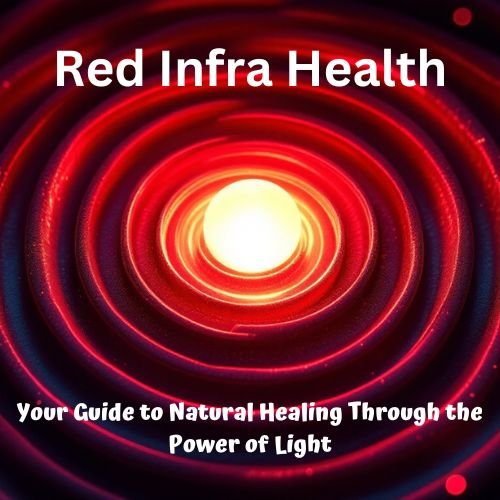


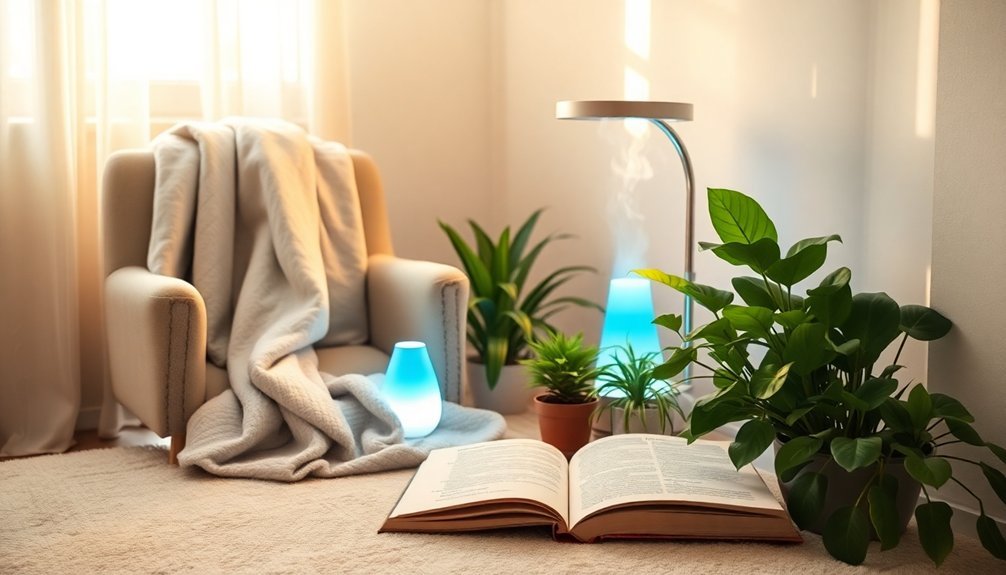
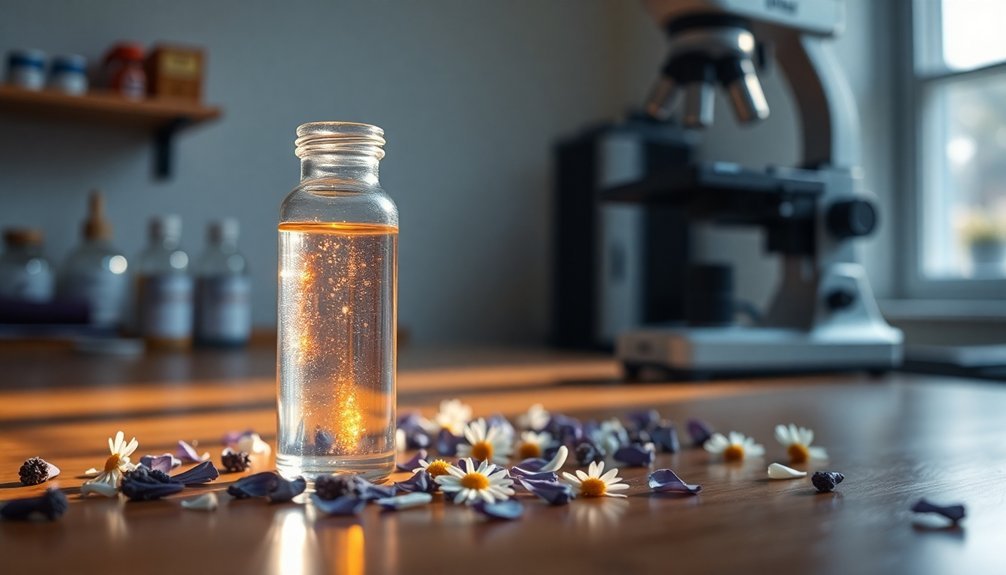
Leave a Reply